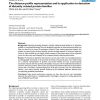Free Online Productivity Tools
i2Speak
i2Symbol
i2OCR
iTex2Img
iWeb2Print
iWeb2Shot
i2Type
iPdf2Split
iPdf2Merge
i2Bopomofo
i2Arabic
i2Style
i2Image
i2PDF
iLatex2Rtf
Sci2ools
BMCBI
2005
2005
The distance-profile representation and its application to detection of distantly related protein families
Background: Detecting homology between remotely related protein families is an important problem in computational biology since the biological properties of uncharacterized proteins can often be inferred from those of homologous proteins. Many existing approaches address this problem by measuring the similarity between proteins through sequence or structural alignment. However, these methods do not exploit collective aspects of the protein space and the computed scores are often noisy and frequently fail to recognize distantly related protein families. Results: We describe an algorithm that improves over the state of the art in homology detection by utilizing global information on the proximity of entities in the protein space. Our method relies on a vectorial representation of proteins and protein families and uses structure-specific association measures between proteins and template structures to form a high-dimensional feature vector for each query protein. These vectors are then p...
| Added | 15 Dec 2010 |
| Updated | 15 Dec 2010 |
| Type | Journal |
| Year | 2005 |
| Where | BMCBI |
| Authors | Chin-Jen Ku, Golan Yona |
Comments (0)

